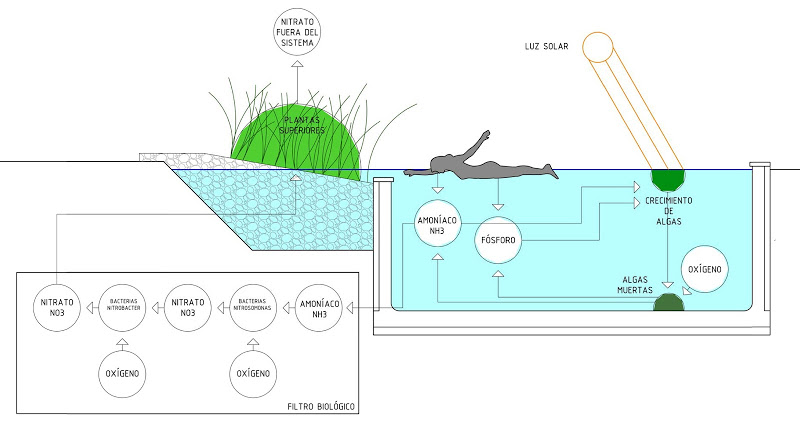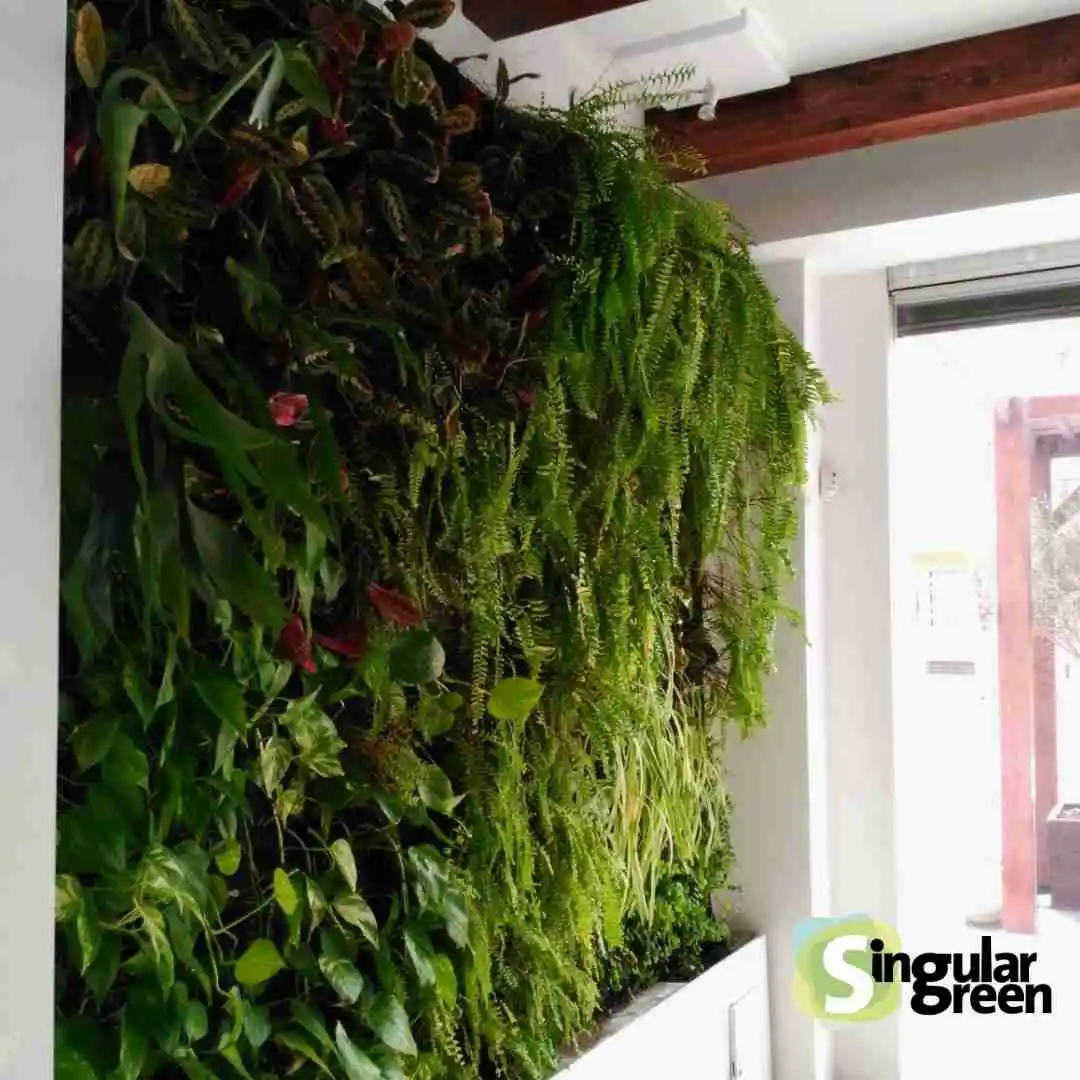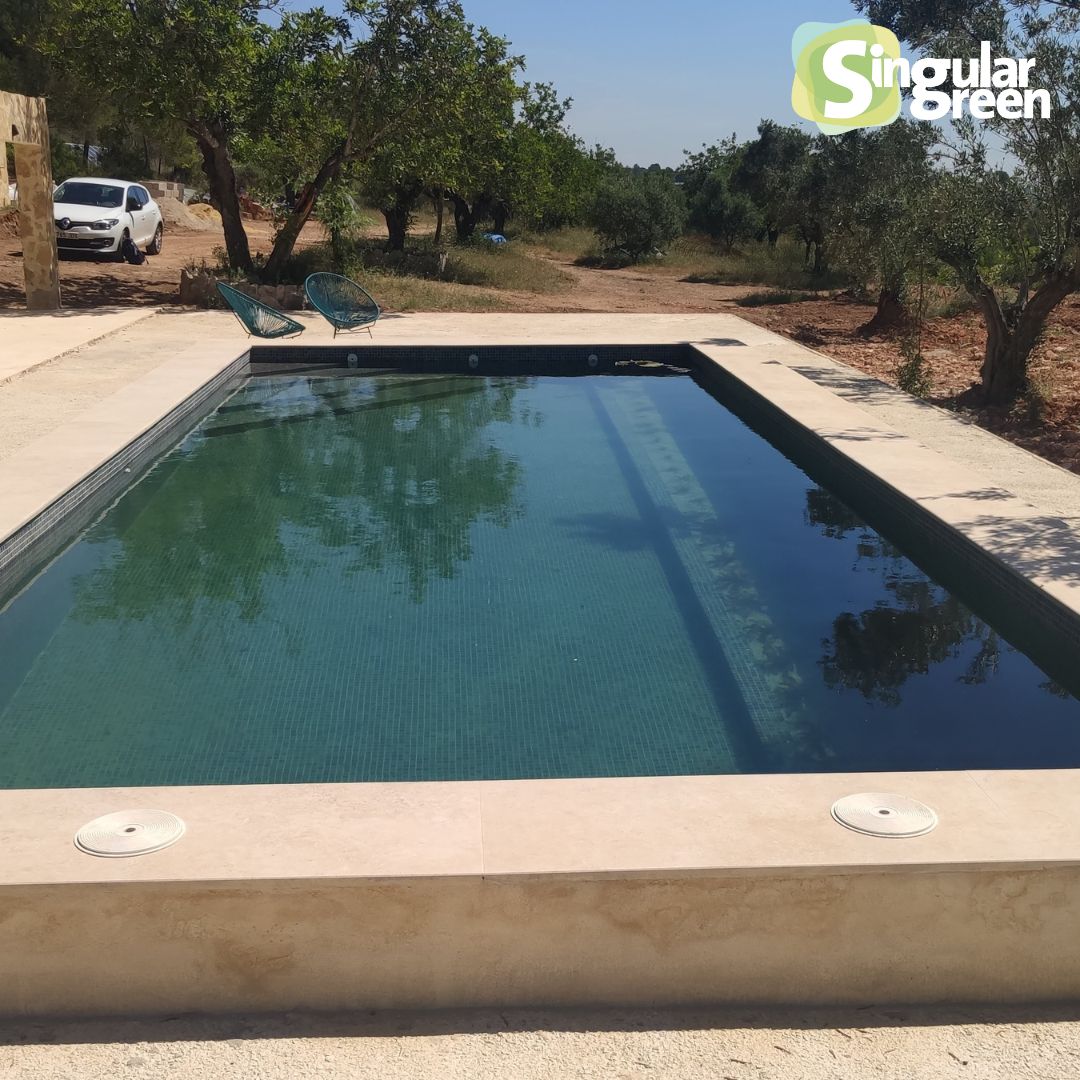In the market you can find several types of purification systems, the most known and common ones such as cartridge, sand and salt, and other purification systems in trend that do not require chemical products and promote biodiversity.

Both are suitable for different sizes and types of pools.
In this article, you will find all the information you need to know about the purifiers for both natural and conventional pools and we will try to explain why it is necessary to purify the water in a pool and how you can do it.
One more thing before we start, one of the most important things for the purification of a pool to work properly is to keep the filters and accessories of the purifiers in good condition to ensure they work properly, so anyone who tells you that a pool does not require maintenance is lying to you.
Pool maintenance and cleaning
The aim of pool cleaning and maintenance is to keep the water crystal clear and free of impurities.
In this article we explained the difference between chemical purification and mechanical purification and so in this article we will not go into this classification again, but we leave you the video in case you want to take a look at it;
The two processes with very different functions and which Jordi talks about in the following video can be found in:
Here are the most popular products and accessories for cleaning and maintaining your pool.
The purification of a swimming pool is mainly associated with what is known asthe ‘pool purifier’;
- This is generally an underground hut or box containing a series of elements and where there is usually a pump and a sand or glass filter (mechanical purification).
- Subsequently, in a swimming pool we will carry out maintenance and purification work with the products that are added (chemical purification, which is generally chlorine).
The importance of understanding the difference between mechanical purification and chemical purification will give you a better understanding of how natural pools work, as they are two very different processes.
Chemicals and accessories for manual cleaning
- Chlorine: This is the chemical product most commonly used to disinfect pool water. There are different types of chlorine: tablets, granulated or liquid. Each has its own advantages and disadvantages. It is important to note that too much chlorine can be detrimental to the health and maintenance of the pool.
- No chlorine or salt is ever used in a natural pool.
- Algaecides: These are used to prevent and eliminate algae that form on the walls and bottom of the pool. There are different types of algaecides depending on the characteristics of the pool.
- In a natural pool, no type of algaecide is used in any case.
- PH: This is the value that indicates the acidity or alkalinity of the water. It is important to control the pH of the pool to keep the water in optimal conditions for swimming. The ideal value in a pool with chlorine and saline chlorination (which is chlorine in smaller quantities) is between 7.2 and 7.6.
- The pH of a natural pool is around 8.5 and it is not very necessary to measure it, as the guarantee that the ecosystem is working is the transparency of the water and the absence of algae on the walls.
Robots and electric pool cleaners
- Robots and electric pool cleaners are an excellent option for pool maintenance. There are models for all types of pools, both in-ground and above ground. They are easy to use and clean the pool effectively. Some models can even be programmed to clean the pool automatically.
- They can be used in a bio-pool, but only in moderation.
Accessories for manual cleaning
- Brushes and hoses: These are essential tools for manual pool cleaning. They allow you to clean the walls, bottom and corners of the pool effectively.
Water disinfection systems: chlorine, salt and natural systems
There are different systems for disinfecting pool water. The two most commonly used are chlorine and salt, but here we are also going to talk about chlorine-free pools.
- Chlorine is the most commonly used method as it is effective and economical. However, too much chlorine can be detrimental to the health of swimmers and to the maintenance of the pool. In addition, chlorine can be irritating to skin and eyes if too high concentrations are used or the pH is not balanced.
- The salt option is newer and increasingly used because it is not harmful to the health of bathers and pool maintenance. The salt is dissolved in the pool water and through a process of electrolysis is converted into natural chlorine . In addition, salt makes swimming more comfortable as it is not irritating to the skin and eyes, but it is still chlorine.
- Finally, and gaining ground little by little, there are bio-pools, which do not require the addition of any chemical product and generate a balanced ecosystem that guarantees the healthiness of the water and gives you clean, crystal-clear water like that of a natural river or lake.
Mechanical purifiers for swimming pools
Water purifiers are essential to keep the water in your pool clean and crystal clear.
There are different types of purifiers on the market, each with its own characteristics and benefits. The following is a description of the different types of scrubbers that can be found:
Types of purifiers: cartridge, sand and salt purifiers
- Cartridge scrubbers are the most economical and easiest to install. They work by retaining particles through an internal filter cartridge. As the cartridge becomes dirty, the pressure increases, indicating that it needs to be cleaned or replaced. These scrubbers are ideal for small to medium sized pools.
- Sand scrubbers are more efficient than cartridge scrubbers. They use a selector valve to control filtration, rinsing, draining and closing operations. Some of these scrubbers come with a timer to regulate the operating time of the system. They are ideal for large or heavily used pools.
- Salt scrubbers are a more modern and environmentally friendly option. They use an electrolysis system to disinfect the water and reduce the amount of chlorine needed. They are ideal for people with sensitive skin or allergies to chlorine.
Filter systems for removable swimming pools
Above ground pool scrubbers are specifically designed for above ground or portable pools. These purifiers can be cartridge, sand or salt, and should be chosen according to the size and use of the pool.
Pool pumps
Pool pumps are the key part of the purification system. They are responsible for pumping and circulating water from the pool through the filter and back into the pool.
Pool pumps are classified according to their power and flow rate, and should be chosen according to the needs of the pool.
Selector valves and accessories for purifiers
- Selector valves are important parts for sand scrubbers. They allow the flow of water through the filter to be controlled, allowing the filter to be operated optimally.
- Filter accessories include products such as pipes, fittings, spare parts and cleaning kits. It is important to choose the right accessories to ensure optimal performance of the purification system.
Tips for filter and filter maintenance
It is important to perform regular maintenance of the scrubbers and filters to ensure that the system is working properly. Some tips include:
- Regular cleaning and replacement of the filter cartridge in cartridge scrubbers.
- Regular replacement of the filter load in sand scrubbers.
- Schedule filtration times and clean the filter at least once a year.
Swimming pool filters. Existing systems for the purification of swimming pools
Pool filters are essential to keep water clean and free of particles, dirt and other debris that cannot be removed by the filtration process.
There are different types of pool filters, including sand, cartridge and glass filters.
Types of filters: sand, cartridge and glass filters
- Sand filters are the most common and work by filtering the water through a layer of sand.
- These filters are capable of retaining larger particles and are suitable for large pools.
- Cartridge filters are smaller and use cartridges of porous material to filter the water.
- They are easy to clean and maintain and are ideal for small to medium sized pools.
- Glass filters are a newer alternative on the market. They use recycled glass as filter media, which is more environmentally friendly.
- They are also more efficient than sand and cartridge filters and can filter out smaller particles.
Filter capacities and flow rates
It is important to select a filter with the right filter capacity and flow rate for the pool, as choosing a filter that does not meet these requirements can result in poor filtration and more costly and difficult pool maintenance. Filter capacity refers to the volume of water the filter can filter, and filter flow rate refers to the amount of water the filter can process in a given period of time.
Filters for inground and above ground pools
Filters for inground and above ground pools vary in size and capacity. It is important to select a filter that suits the specific needs and requirements of the pool. There are filters designed specifically for in-ground pools and others for above ground pools. In addition, some filters can be used in both types of pools. It is important to consider the size of the pool, the water flow and the type of filter before making any purchase.
Swimming pool filtration systems
Filtration systems are essential in the maintenance of a swimming pool, ensuring clean, quality water for swimming. These systems include electrical panels and pressure groups, skimmers and bottom drains, as well as a wide variety of salt chlorinators and heat pumps.
Electrical panels and booster sets
Electrical panels and booster sets are essential for the correct operation of the treatment plant and filtration system. These elements allow the pump speed and water flow rate to be controlled, adjusting to the needs of each pool. They also allow you to programme the filtration times and cycles necessary for correct operation.
Skimmers and bottom drains
Skimmers and bottom drains are essential for the elimination of floating waste and particles deposited on the bottom of the pool. They are key elements in the filtration system, as they trap dirt, leaves, insects and other objects that can accumulate in the water.
Salt chlorinators and heat pumps
Salt chlorinators and heat pumps are elements that keep the pool water in perfect condition, preventing the proliferation of bacteria and algae, as well as the appearance of limescale and other deposits in the water.
Salt chlorinators make use of the salt present in the water to produce chlorine, while heat pumps allow the water to be kept at the right temperature all year round.
Tips on the maintenance of purifiers and filters
Cleaning and replacing filter cartridges and filter loads
To ensure that your cartridge filter is working properly, it is important to clean and maintain the cartridges on a regular basis. If the cartridge is dirty or worn, it is advisable to replace it. To clean the cartridge, it should be removed from the filter and rinsed with pressurised water. It is important not to use abrasive chemicals for cleaning. If the cartridge has marks of wear or breakage, it is advisable to replace it with a new one. In the case of the filter load, replacement is also something that should be done regularly. The service life of the load varies according to the model and the conditions in which the filter is used. It is important to monitor the efficiency of the load and, if a decrease in water quality or an increase in pressure is noticed, it is advisable to seek guidance about replacement.
Cleaning the sand filter and replacing the flint load
The sand filter is one of the most common filters in swimming pools.
It is important to clean the filter regularly to keep it in optimum condition. To clean it, the water supply to the filter must be turned off. Next, open the purge valve and clean out the sand that accumulates at the bottom of the tank. Subsequently, the flush valve is opened and the water is allowed to flow out of the filter. The flint load can last for several years, although regular maintenance is important to maintain water quality. If the scrubber is not working effectively or the water is not clean enough, this may be an indication that the flint load needs to be replaced.
Scheduling filtration and maintenance times
Regular maintenance is essential to ensure the correct operation of the scrubber and to prolong its life.
The correct programming of the scrubber and filtration times is essential.
It is important to choose the right length of each filtration cycle, taking into account the amount of water in the pool, the characteristics of the filter and the use made of the pool.
In general, it is recommended that the purifier in chlorinated pools should run for six to eight hours a day in high season and four to six hours a day in low season.
In a natural pool, it is sufficient to turn it on only to clean the leaves and possible elements that have fallen in the pool. The recirculation of the biological filter with an energy-saving pump should be switched on 24 hours a day.
It is important to establish a maintenance routine that includes regular checking of the level of the filter load, cleaning of the scrubber and regular replacement of the filters if any.
By following a regular maintenance routine, you can ensure that the filter will work properly for a long time.







